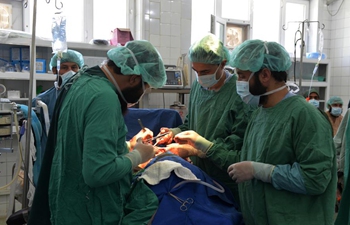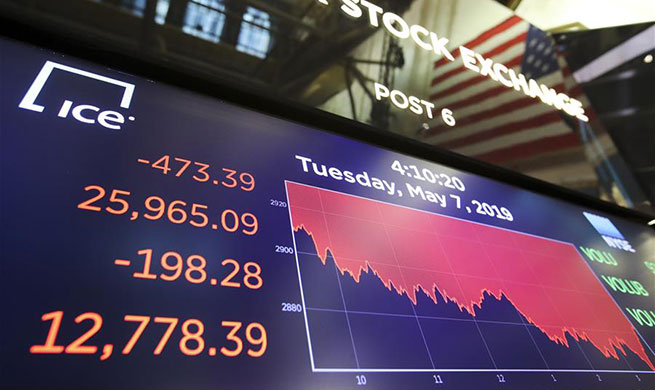WASHINGTON, May 7 (Xinhua) -- Newly released data on the U.S. labor market send conflicting signals to the U.S. Federal Reserve, which has been caught in a debate on whether to cut interest rates.
Performing better than expected, U.S. employers added 263,000 new jobs in April, and the unemployment rate dropped by 0.2 percentage point to 3.6 percent, the lowest since December 1969, the U.S. Bureau of Labor Statistics said Friday in its employment situation report.
The employment data, however, might not seem all that promising. Diane Swonk, the chief economist at Grant Thornton, a major accounting firm, said "the fly in the ointment" is that a good portion of that decline was due to a loss in participation in the labor force, which means that many have given up looking for a job.
"We have seen a drop in participation for two months in a row," she said in a post.
The labor force participation rate declined by 0.2 percentage point to 62.8 percent in April, as the number of Americans in the labor force shrank by almost 500,000 in the month, the highest in one and a half years.
A broader measure of unemployment that includes those who are unemployed, marginally attached to the labor force, and working part-time for economic reasons, remained at 7.3 percent in April.
Meanwhile, slower expansion in both manufacturing and services sectors in the month has suggested that economic growth may be leveling off, according to recent data from the Institute for Supply Management (ISM).
The non-manufacturing index (NMI), which gauges the performance of the services sector, was 55.5 percent in April, down 0.6 percentage point from the March reading, while the purchasing managers' index (PMI), which gauges the performance of the manufacturing sector, registered 52.8 percent, down by 2.5 percentage points from the March reading.
As shown in the employment situation report, wage increases didn't come as fast as expected, despite that U.S. unemployment rate remained below 4 percent over the past year.
Average hourly earnings for all private-sector workers rose by 6 cents, or 0.2 percent, to 27.77 U.S. dollars. Over the year, average hourly earnings have increased by 3.2 percent.
Analysts say the mild wage increase isn't sufficient to push up inflation. Excluding the volatile energy and food prices, the core personal consumption expenditures (PCE) price index, a preferred inflation gauge by the Fed, was up 1.3 percent in the first quarter, still below the central bank's target of 2 percent.
U.S. President Donald Trump and other White House officials have recently urged the Fed to cut interest rates, citing soft inflation data. "I think it might be time for us to consider lowering interest rates," Vice President Mike Pence told CNBC on Friday. "We just don't see any inflation in this economy at all."
"If the Fed is serious about the inflation target, then the odds favor a rate cut over a rate hike," Tim Duy, a long-time Fed watcher and professor at the University of Oregon, wrote in a blog post last week.
Several Fed officials have also voiced concern over weakness in inflation. St. Louis Federal Reserve President James Bullard and Chicago Fed President Charles Evans have both recently expressed that they are open to a rate cut if U.S. economy continues to see tepid inflation in the coming months.
After concluding its policy meeting last week, the Fed, however, left interest rates unchanged and downplayed concerns about weak inflation, as the central bank saw no need to alter its "patient" approach on interest-rate moves.
"Inflation is low, which gives us the ability to be patient and we do expect it to move up and we want it to move up to 2 percent," Fed Chairman Jerome Powell said Wednesday at a press conference, arguing that the recent weakness in price pressures is likely "transient".
"We think that our policy stance is appropriate at the moment. And we don't see a strong case for moving in either direction," Powell said.
Fed Vice Chairman Richard Clarida on Tuesday reaffirmed the central bank's position, saying that the U.S. economy and Fed monetary policy are in "a good place." In an interview with Bloomberg TV, Clarida said most members of the Federal Open Market Committee (FOMC), the Fed's policy-making body, see the baseline rate unchanged this year.
In his earlier remarks, Clarida said U.S. economy is operating "at or very close" to the Fed's dual-mandate objectives of maximum employment and price stability, and the current policy rate is in the range of FOMC participants' estimates of "neutral."
Swonk said the U.S. central bank is "walking a tightrope," balancing the current low rate of inflation against the risk of stoking additional asset bubbles. "This will leave the Fed firmly on the sidelines this year," she said.
The Fed approved four rate hikes in 2018, continuing a move toward policy normalization that began in 2015. Since the beginning of this year, the central bank has left interest rates unchanged and pledged to be patient in future hikes.
In a recent report, Goldman Sachs said an increase is more likely than a cut. "The low level of the funds rate makes a 'recalibration' cut very unlikely, and neither we nor Fed officials see the risk of recession as elevated," its analysts wrote.
In the latest European Economic Forecast released Tuesday, the European Union warned that accommodative U.S. monetary policy at times when the economy is at full employment risks exacerbating imbalances and vulnerabilities," especially as some asset valuations appear to be stretched and debt levels continue to rise."
In its latest economic projections released in March, the Fed cut its forecast of the U.S. economic growth for 2019 and 2020, expecting a rate of 2.1 percent and 1.9 percent, respectively.
The Goldman Sachs anticipates the next Fed rate hike in the fourth quarter of 2020, after the presidential campaign, citing political pressure on monetary policy. A Bloomberg report last week, however, said traders maintained bets the Fed will lower rates by mid-2020.
According to a survey by The Wall Street Journal in April, the majority of some 60 economists believe that the Fed will keep interest rates unchanged at least through the end of 2021.













